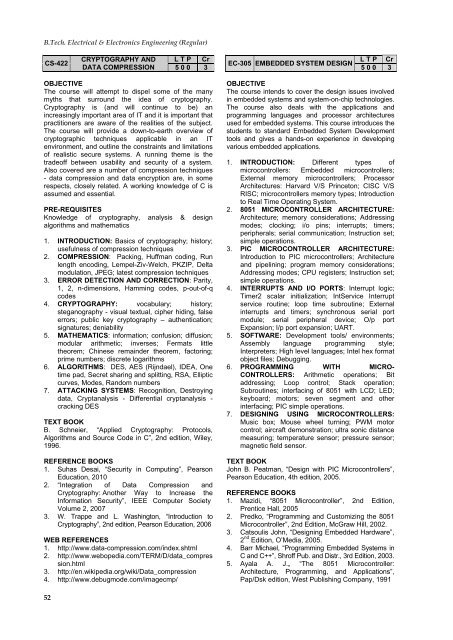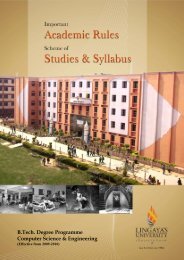Electrical and Electronics - Lingaya's University
Electrical and Electronics - Lingaya's University
Electrical and Electronics - Lingaya's University
You also want an ePaper? Increase the reach of your titles
YUMPU automatically turns print PDFs into web optimized ePapers that Google loves.
B.Tech. <strong>Electrical</strong> & <strong>Electronics</strong> Engineering (Regular)CS-422CRYPTOGRAPHY ANDDATA COMPRESSIONL T P Cr5 0 0 3EC-305 EMBEDDED SYSTEM DESIGNL T P Cr5 0 0 3OBJECTIVEThe course will attempt to dispel some of the manymyths that surround the idea of cryptography.Cryptography is (<strong>and</strong> will continue to be) anincreasingly important area of IT <strong>and</strong> it is important thatpractitioners are aware of the realities of the subject.The course will provide a down-to-earth overview ofcryptographic techniques applicable in an ITenvironment, <strong>and</strong> outline the constraints <strong>and</strong> limitationsof realistic secure systems. A running theme is thetradeoff between usability <strong>and</strong> security of a system.Also covered are a number of compression techniques- data compression <strong>and</strong> data encryption are, in somerespects, closely related. A working knowledge of C isassumed <strong>and</strong> essential.PRE-REQUISITESKnowledge of cryptography, analysis & designalgorithms <strong>and</strong> mathematics1. INTRODUCTION: Basics of cryptography; history;usefulness of compression techniques2. COMPRESSION: Packing, Huffman coding, Runlength encoding, Lempel-Ziv-Welch, PKZIP, Deltamodulation, JPEG; latest compression techniques3. ERROR DETECTION AND CORRECTION: Parity,1, 2, n-dimensions, Hamming codes, p-out-of-qcodes4. CRYPTOGRAPHY: vocabulary; history;steganography - visual textual, cipher hiding, falseerrors; public key cryptography – authentication;signatures; deniability5. MATHEMATICS: information; confusion; diffusion;modular arithmetic; inverses; Fermats littletheorem; Chinese remainder theorem, factoring;prime numbers; discrete logarithms6. ALGORITHMS: DES, AES (Rijndael), IDEA, Onetime pad, Secret sharing <strong>and</strong> splitting, RSA, Ellipticcurves, Modes, R<strong>and</strong>om numbers7. ATTACKING SYSTEMS: Recognition, Destroyingdata, Cryptanalysis - Differential cryptanalysis -cracking DESTEXT BOOKB. Schneier, ―Applied Cryptography: Protocols,Algorithms <strong>and</strong> Source Code in C‖, 2nd edition, Wiley,1996.REFERENCE BOOKS1. Suhas Desai, ―Security in Computing‖, PearsonEducation, 20102. ―Integration of Data Compression <strong>and</strong>Cryptography: Another Way to Increase theInformation Security‖, IEEE Computer SocietyVolume 2, 20073. W. Trappe <strong>and</strong> L. Washington, ―Introduction toCryptography‖, 2nd edition, Pearson Education, 2006WEB REFERENCES1. http://www.data-compression.com/index.shtml2. http://www.webopedia.com/TERM/D/data_compression.html3. http://en.wikipedia.org/wiki/Data_compression4. http://www.debugmode.com/imagecmp/OBJECTIVEThe course intends to cover the design issues involvedin embedded systems <strong>and</strong> system-on-chip technologies.The course also deals with the applications <strong>and</strong>programming languages <strong>and</strong> processor architecturesused for embedded systems. This course introduces thestudents to st<strong>and</strong>ard Embedded System Developmenttools <strong>and</strong> gives a h<strong>and</strong>s-on experience in developingvarious embedded applications.1. INTRODUCTION: Different types ofmicrocontrollers: Embedded microcontrollers;External memory microcontrollers; ProcessorArchitectures: Harvard V/S Princeton; CISC V/SRISC; microcontrollers memory types; Introductionto Real Time Operating System.2. 8051 MICROCONTROLLER ARCHITECTURE:Architecture; memory considerations; Addressingmodes; clocking; i/o pins; interrupts; timers;peripherals; serial communication; Instruction set;simple operations.3. PIC MICROCONTROLLER ARCHITECTURE:Introduction to PIC microcontrollers; Architecture<strong>and</strong> pipelining; program memory considerations;Addressing modes; CPU registers; Instruction set;simple operations.4. INTERRUPTS AND I/O PORTS: Interrupt logic;Timer2 scalar initialization; IntService Interruptservice routine; loop time subroutine; Externalinterrupts <strong>and</strong> timers; synchronous serial portmodule; serial peripheral device; O/p portExpansion; I/p port expansion; UART.5. SOFTWARE: Development tools/ environments;Assembly language programming style;Interpreters; High level languages; Intel hex formatobject files; Debugging.6. PROGRAMMING WITH MICRO-CONTROLLERS: Arithmetic operations; Bitaddressing; Loop control; Stack operation;Subroutines; interfacing of 8051 with LCD; LED;keyboard; motors; seven segment <strong>and</strong> otherinterfacing; PIC simple operations.7. DESIGNING USING MICROCONTROLLERS:Music box; Mouse wheel turning; PWM motorcontrol; aircraft demonstration; ultra sonic distancemeasuring; temperature sensor; pressure sensor;magnetic field sensor.TEXT BOOKJohn B. Peatman, ―Design with PIC Microcontrollers‖,Pearson Education, 4th edition, 2005.REFERENCE BOOKS1. Mazidi, ―8051 Microcontroller‖, 2nd Edition,Prentice Hall, 20052. Predko, ―Programming <strong>and</strong> Customizing the 8051Microcontroller‖, 2nd Edition, McGraw Hill, 2002.3. Catsoulis John, ―Designing Embedded Hardware‖,2 nd Edition, O‘Media, 2005.4. Barr Michael, ―Programming Embedded Systems inC <strong>and</strong> C++‖, Shroff Pub. <strong>and</strong> Distr., 3rd Edition, 2003.5. Ayala A. J., ―The 8051 Microcontroller:Architecture, Programming, <strong>and</strong> Applications‖,Pap/Dsk edition, West Publishing Company, 199152
















